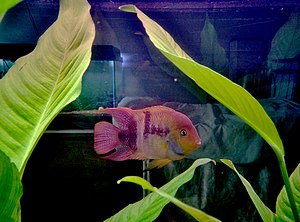Sajica cichlid
| Sajica cichlid | ||||||||||||
|---|---|---|---|---|---|---|---|---|---|---|---|---|

Amatitlania sajica |
||||||||||||
| Systematics | ||||||||||||
|
||||||||||||
| Scientific name | ||||||||||||
| Amatitlania sajica | ||||||||||||
| ( Bussing , 1974) |
The Sajica cichlid ( Amatitlania sajica , Syn . : Cichlasoma sajica , Cryptoheros sajica , Archocentrus sajica ), also called Costa Rican cichlid among aquarists , is a rather peaceful representative of the cichlid family from Central America .
Occurrence
The Sajica cichlid is a Central American freshwater fish that originates from southern Costa Rica between the Punto Mala and the Rio Esquinas Basin.
It comes from river biotopes with stones, hiding places and sandy soil or fine gravel in which it digs. Overall, the Sajica cichlid is considered to be relatively robust and adaptable in terms of water parameters . The water temperature in its area of distribution is between 22 ° C and 27 ° C. The pH value is 6.5–7.5.
Appearance
The male Sajica cichlid can reach a size of around 18 centimeters, which is rarely exceeded. The female, on the other hand, stays at around 12 centimeters.
His body is slender and compressed on the sides. The head is blunt and has very pronounced lips. The body has a gray-blue to gray color, besides it has darker stripes and bandages. When excited, the Sajica is able to change its color very quickly to almost black. On the lower edge of the gill cover, as well as on the sides of the body and the edges of the fins, there are often bright bluish spots.
A gender difference is clearly visible on the outside. The males possess adult a high forehead age and the fins are reddish. The females, on the other hand, have only a flat forehead and the fins are yellowish.
behavior
Overall, Sajica cichlids are rather calm. During the mating season they can develop a high level of aggressiveness towards one another and towards other fish . During the mating and breeding season, they can approach the aquarist while handling the aquarium, which speaks for their high brood care.
With the zebra cichlid ( Archocentrus nigrofasciatus , Syn .: Cichlasoma nigrofasciatum , Cryptoheros nigrofasciatum ) there are certainly crossings, as both are very closely related. The socialization of both species must therefore be avoided in private aquariums.
Mating and rearing behavior
The actual spawning is preceded by a very long courtship behavior, which in young and inexperienced fish can drag on for months. The male digs pits and also undermines structures, which serves to impress. The female sometimes uses these places to spawn and the breeding site is cleaned by both partners. In many cases, all plants and stones are removed from this area. The area is strongly defended from then on.
The Sajica cichlid is an open breeder . He likes to choose caves for spawning. The Sajica cichlid pairs practice intensive brood care before and after hatching.
The first clutches contain around 300 eggs and these show a yellowish color. They hatch after just three days. The larvae are repeatedly reburied in different pits. After five days, the fry can swim freely and eat.
nutrition
In the wild, this fish feeds on other fish , earthworms , crustaceans , insects , small frogs, and mollusks . But in the aquarium hobby it can also be satisfied with dry food and live food. A varied diet is essential.
Aquarium keeping
The Sajica cichlid is very popular in private aquariums and can often be seen in community aquariums with fish of the same size. Breeding success is also high, and various breeding forms are now available.
Hints
- ↑ List of ornamental fish Sajica cichlid
- ^ Wally Kahl, Burkard Kahl, Dieter Vogt: Kosmos-Atlas aquarium fish. Franckh-Kosmos, Stuttgart 2003, ISBN 3-440-09476-6 , page 198
- ↑ Hans J. Mayland: Freshwater Aquarium. Falken, Niedernhausen 1985, ISBN 3-8068-4191-8 , page 254
literature
- William A. Bussing: Peces de las aguas continentales de Costa Rica (Freshwater Fishes of Costa Rica). Ed. de la Univ. de Costa Rica, San José 1998, ISBN 9977-67-489-2 .
- Rainer Stawikowski, Uwe Werner: The cichlids of America. Volume 1. Ulmer, Stuttgart 1998, ISBN 3-8001-7270-4 .
- Rüdiger Riehl , Hans A. Baensch : Aquarium Atlas. Volume 2. 9th edition. Mergus, Melle 2004, ISBN 3-88244-014-7 .
Web links
- Sajica cichlid on Fishbase.org (English)
- Ornamental fish directory